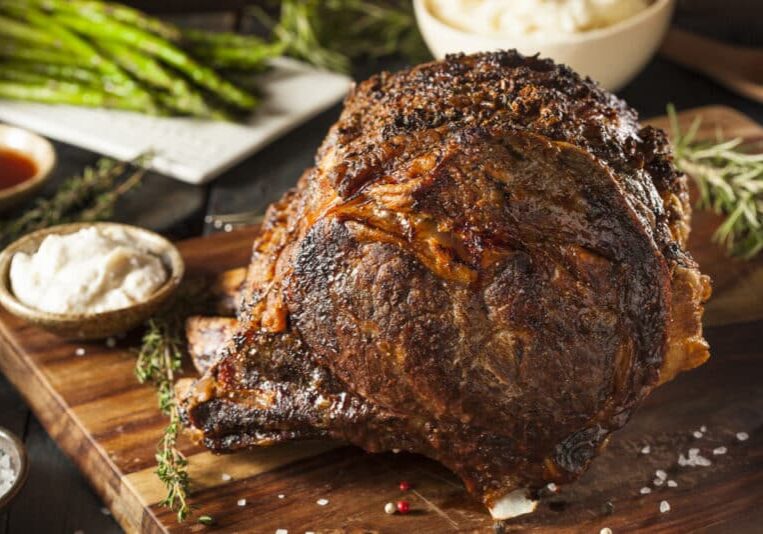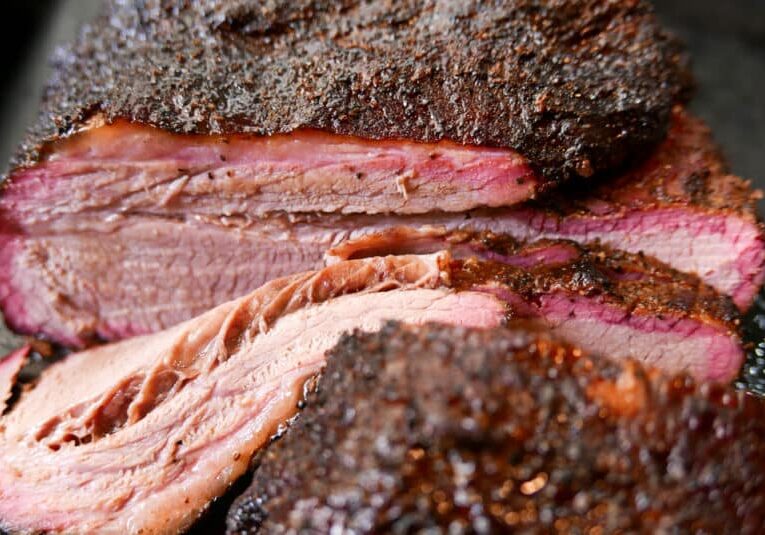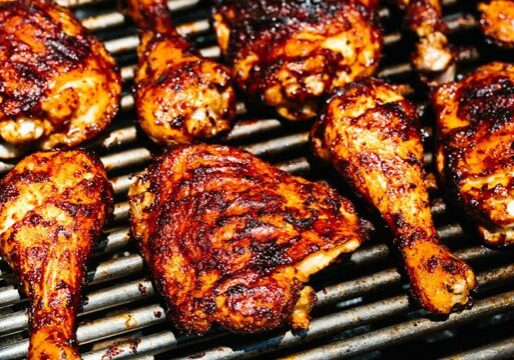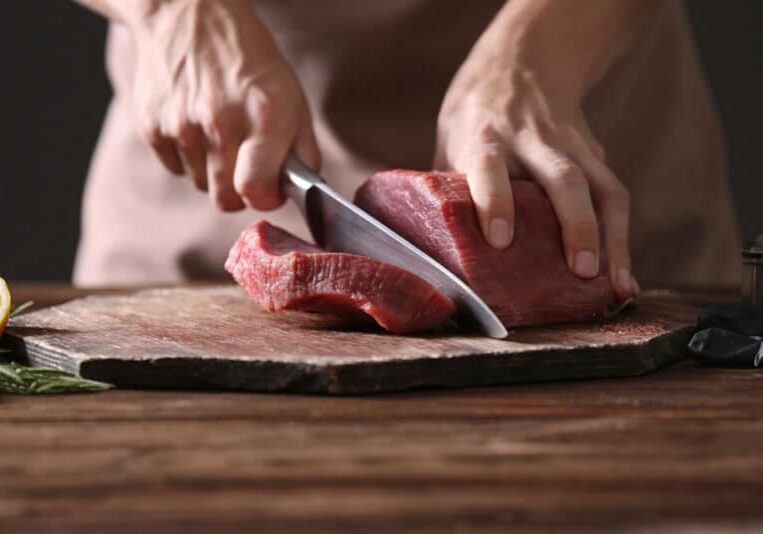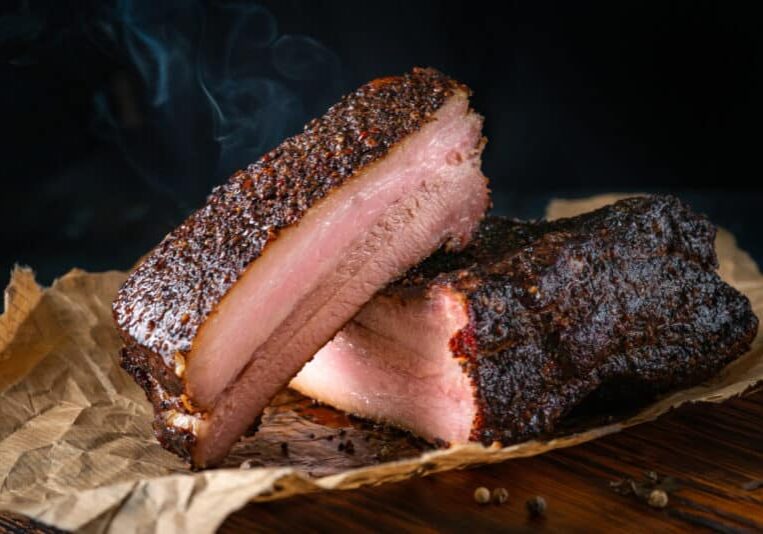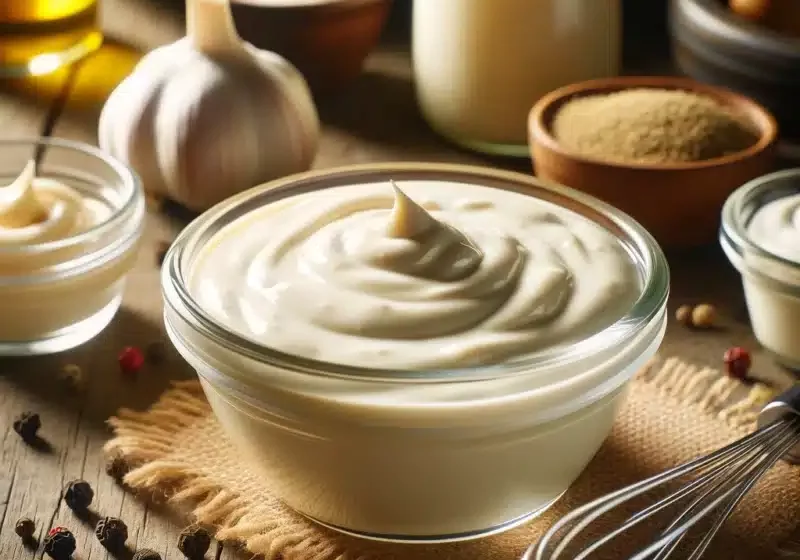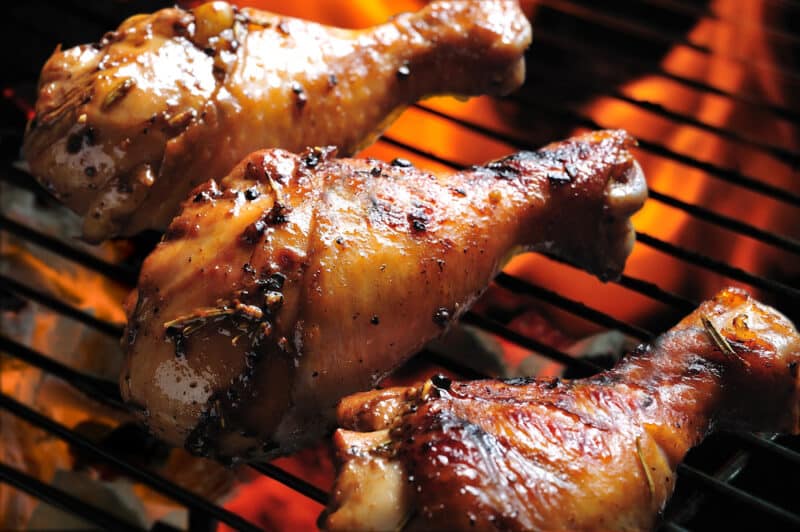Best Meats to Smoke (Top 10 For Max Flavor)
TheGrillingMaster.com is reader-supported. If you buy something using the links on our site, we might earn an affiliate commission at no added cost to you. This helps us pay our staff to keep making awesome content for you!

The Top 10 Best Meats for Smoking
-
Brisket: This is perhaps the most iconic smoking meat, prized for its rich flavor and tenderness when slow-cooked over a low flame.
-
Pork Shoulder/Boston Butt: Ideal for pulled pork, its high fat content renders down over a long smoke, creating a tender, flavorful dish.
-
Beef Ribs: With a lot of marbled fat, beef ribs are excellent for smoking, delivering a big, meaty flavor.
-
Whole Chicken: A staple for any smoker, whole chicken absorbs the smoky flavors beautifully, creating a tasty twist on a classic.
-
Salmon: Seafood, like salmon, takes well to smoking. The result is a delicate, smoky flavor that complements the fish’s natural richness.
-
Pork Spare Ribs: A classic BBQ favorite, spare ribs become fall-off-the-bone tender and extremely tasty when smoked.
-
Turkey: Smoking a whole turkey adds a depth of flavor that roasting simply can’t match.
-
Tri-tip: A less common cut, the tri-tip is a lean, flavorful piece of beef that’s excellent for smoking.
-
Pork Belly: When smoked, the fatty pork belly becomes tender and richly flavorful, a true treat for any BBQ lover.
-
Lamb Shoulder: Not traditionally smoked as often as other meats, lamb shoulder can be incredibly delicious with a rich, smoky flavor that’s robust and satisfying.
Smoking meats is an age-old practice that I’ve been enamored with for as long as I can remember.
The transformative power of smoke, turning raw ingredients into succulent meals, is nothing short of magic.
This process isn’t simply about cooking—it’s a meditative ritual that starts with choosing the right cut of meat and pairing it with the perfect wood to enhance its flavors.
Each type of wood has its unique personality, adding subtleties to the flavor profile.
Hickory might provide robustness while applewood imparts a sweeter note. Together, the meat and wood embark on a smoky journey, delivering a feast that’s a celebration of taste and tradition.
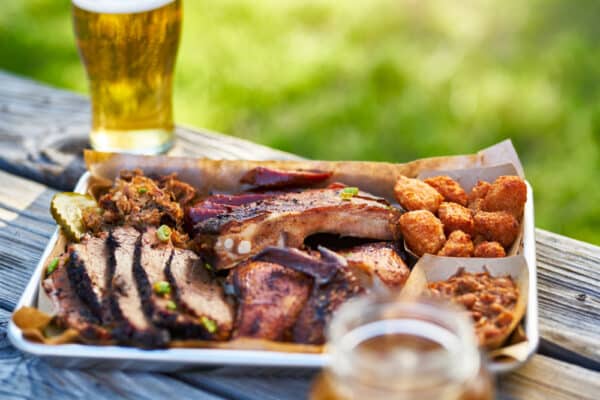
1. Brisket:
- Description: Large, tough beef cut that turns tender and flavorful after a long smoke.
- Smoke Point Temperature: 190-205°F
2. Pork Shoulder:
- Description: High fat content makes it ideal for pulled pork sandwiches.
- Smoke Point Temperature: 195-205°F
3. Ribs:
- Description: Comes in various styles; known for the signature ‘smoke ring’ beneath.
- Smoke Point Temperature: 190-203°F
4. Chicken:
- Description: Whole chickens or parts can be smoked; best when brined first.
- Smoke Point Temperature: 165 (whole), 170 (breasts), 175-180 (thighs/wings)
5. Turkey:
- Description: A whole smoked turkey is a Thanksgiving showstopper.
- Smoke Point Temperature: 165°F
6. Salmon:
- Description: Fatty content keeps the fish moist with a rich flavor.
- Smoke Point Temperature: 140-145°F
7. Sausages:
- Description: Quick-cooking and virtually fail-proof; great for beginners.
- Smoke Point Temperature: 160-165°F
8. Pork Belly:
- Description: Slow-rendered fat results in melt-in-your-mouth slices, akin to bacon.
- Smoke Point Temperature: 195-203°F
9. Tri-Tip:
- Description: Leaner beef cut that when smoked right, offers a steak-like roast.
- Smoke Point Temperature: 135°F (for medium-rare)
The Art and Science of Smoking
At the heart of smoking lies an interplay of art and science. It’s about mastering the subtle balance of heat, smoke, time, and meat—a delicate dance that can result in the most flavorful, succulent dishes when performed correctly.
Let’s start with the basics of the smoking process. Smoking is a low and slow cooking method that uses wood smoke to impart flavor into meats. This is done in a smoker, a special kind of grill designed to maintain low cooking temperatures for extended periods of time. The wood chips or chunks used in smoking are soaked in water, which allows them to smolder and produce smoke without catching fire. When this smoke is absorbed by the meat, it imparts unique flavors depending on the type of wood used.
Now, let’s talk about the significance of time and temperature in smoking. The ‘low and slow’ approach isn’t just a catchy phrase; it’s a fundamental rule in smoking. Cooking at low temperatures, usually between 200 and 275 degrees Fahrenheit, for several hours allows the collagen in the meat to break down slowly without drying out the meat. This results in a mouthwateringly tender and moist product. Rush this process, and you’ll be left with tough and dry meat.
One of the exciting aspects of smoking meat is the “smoke ring” – that coveted pink ring just beneath the surface of the meat. This is a sign of well-smoked meat and is the result of a chemical reaction between the smoke and the myoglobin in the meat. This reaction creates a pink color, hence the term “smoke ring”. Achieving a smoke ring is often considered a badge of honor among smoking enthusiasts.
The art of smoking meat, then, involves more than simply placing meat in a smoker. It’s about understanding how different elements interact with each other—how heat and smoke work together to break down the proteins and fats in the meat, how different cuts respond to this process, and how flavors develop over time.
Pro Tip: Be sure to season your meat before smoking it!

Beef Cuts Perfect for Smoking
When it comes to smoking, beef cuts hold a special place in my heart. There’s a wide variety of cuts, each with a unique texture and flavor profile, that all respond remarkably well to a long, slow smoke.
The brisket is, without a doubt, the crown jewel of smoking meats. Its transformation during smoking is nothing short of miraculous. This hefty cut of beef, originating from the lower chest of the cow, starts off tough and sinewy. But after hours of slow cooking in the smoker, it transforms into a juicy, tender, and incredibly flavorful delicacy that’s a hit at any barbecue. Mastering brisket takes time and patience, but the result is undeniably worth the effort.
Beef ribs are another personal favorite. These large, primal cuts, packed with marbled fat, render down beautifully in the smoker. The end product is meat that’s incredibly tender, falling off the bone, and imbued with the smoky flavor absorbed over hours of cooking.
The Tri-tip is a lesser-known cut but one that definitely deserves more recognition. It’s a lean and flavorful cut from the bottom of the sirloin. While it requires careful monitoring due to its lower fat content, a smoked tri-tip is a tender and delicious reward.
Last but not least, beef short ribs. Think of these as beef ribs’ smaller, but equally tasty, cousin. With a good amount of marbling and a large bone running through the center, they absorb the smoky flavor wonderfully, resulting in a rich, beefy flavor that’s hard to beat.
Each of these cuts has its unique characteristics and brings something different to the table. Experimenting with these various cuts is one of the joys of smoking, and finding your personal favorite is all part of the journey. After all, the beauty of smoking lies not just in the destination (the finished product), but also in the journey (the process).
Discover the best sides for Smoked Tri Tip here.

Poultry That Loves Smoke
Smoking is not solely about the hefty, robust meats like beef and pork. Poultry, with its leaner texture and delicate flavors, can also be an outstanding choice for smoking. Here, we delve into some of the best poultry options that thrive under the careful attention of a smoking enthusiast.
The classic chicken is always a popular choice. Smoking a whole chicken allows for a rich, even flavor throughout the meat, creating a juicy and tender result. I often recommend starting with a brine or rub to impart additional flavor to the bird. This process also helps retain moisture during the long smoking process. When the smoke permeates the chicken, it amplifies the bird’s inherent flavors, creating a smoky, tender, and absolutely delicious dish that goes beyond the typical roasted or grilled chicken.
Turkey, traditionally a highlight of Thanksgiving dinners, often undergoes a transformation when smoked. It absorbs the smoky flavor beautifully, creating a bird that is not only moist but packed full of flavor. It’s crucial to monitor the temperature during smoking, given turkey’s propensity to dry out. Yet, with care and patience, a smoked turkey can become a holiday favorite, offering a smoky twist on a classic meal.
Duck, another favorite in the poultry family, is also a superb candidate for smoking. With its richer, more robust flavors and a significant fat layer, duck reacts exceptionally well to smoking. As the fat slowly renders during the cooking process, it bastes the meat, keeping it moist while adding flavor. The resulting smoked duck has a crisp, tasty skin and tender, juicy meat that’s an absolute delight to eat.
In my experience, the key to smoking poultry successfully lies in the balance between time, temperature, and smoke. It’s essential to remember that poultry, generally leaner than red meat, can dry out if exposed to heat for too long. Therefore, monitoring the internal temperature with a meat thermometer is a must to ensure your bird doesn’t overcook.
Furthermore, choosing the right type of wood is vital to complement rather than overpower the subtle flavors of poultry. Fruitwoods like apple or cherry provide a lighter, sweeter smoke that works perfectly with poultry, enhancing its natural flavors rather than masking them.
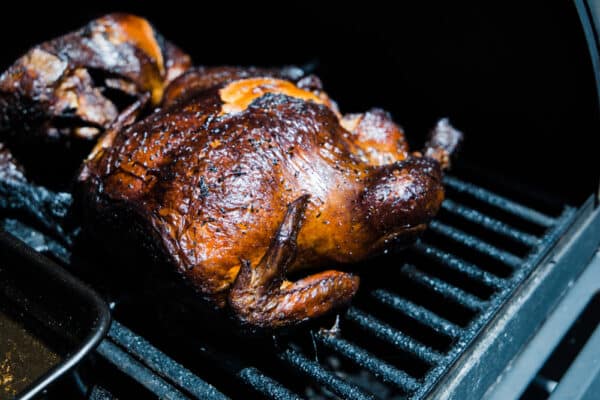
Pork Cuts You Must Try to Smoke
When it comes to smoking, I often find myself drawn to pork. With its fantastic marbling, diversity of cuts, and inherently delicious flavor, pork is incredibly well-suited to the smoking process. Here are a few of my favorite pork cuts that I believe truly shine when subjected to the low and slow cooking method of a smoker.
Pork shoulder, often referred to as Boston Butt, holds a special place in my heart, particularly for making pulled pork. This cut has a good amount of connective tissue and fat, which slowly renders out during the smoking process. The result? A tender, pull-apart texture and rich, mouthwatering flavor that is perfect for sandwiches or tacos. My top tip for smoking pork shoulder is to be patient. This cut benefits from a long smoke, so give it the time it needs to reach its full potential.
Another favorite of mine is spare ribs. These are a barbecue classic, and for good reason. The layers of meat and fat around the ribs take on smoke flavor incredibly well. After a few hours in the smoker, you’re rewarded with succulent, smoky, and tender ribs that are a real crowd-pleaser. Remember, the key to perfect ribs lies in monitoring your heat and smoke – keep things consistent for the best results.
Lastly, I can’t talk about smoking pork without mentioning pork belly. This cut is an absolute delight in the smoker. Its high-fat content renders down to create an incredibly flavorful, tender, and almost melt-in-your-mouth experience. You might be familiar with pork belly in the form of bacon, but trust me when I say that a smoked, unsliced pork belly is a game-changer.
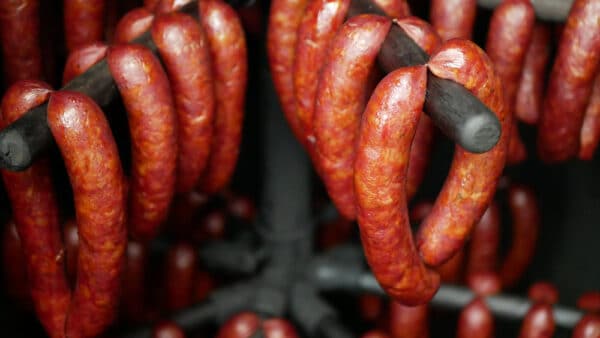
Seafood Selections for Smoking
When discussing smoking meats, it’s easy to overlook the incredible variety and flavor that seafood can bring to the table. From the rich, buttery texture of salmon to the robust flavors of tuna and the delicate taste of shrimp, seafood offers a wonderful change of pace and a delightful diversity of flavors.
Starting with salmon, I find this fish to be a real gem when it comes to smoking. The inherently rich and oily nature of salmon makes it perfect for absorbing the smoky flavor. When properly smoked, salmon can be incredibly delicate and flavorful, maintaining its moisture and offering a distinct taste that is both smoky and subtly sweet. It’s also very forgiving for those new to smoking seafood, as its fattiness helps prevent it from drying out.
Tuna, with its firm texture and strong flavor, is another seafood that stands up well to smoking. It’s important to remember that tuna is a lean fish, which means it can become dry if overcooked. Monitoring your temperatures is key to achieving a perfectly smoked tuna. When done right, you’re rewarded with a smoky, meaty fish that’s a true delight. I often enjoy smoked tuna in salads, sandwiches, or simply served with a drizzle of fresh lemon juice.
Then, there’s shrimp. Shrimp might seem like an unusual choice for smoking, given their small size and quick cooking time. But, don’t be fooled! Smoking can impart a fantastic depth of flavor to shrimp. The key is to keep a close eye on them, as overcooking can result in tough, rubbery shrimp. But, with careful timing, smoked shrimp can be a quick and delicious treat that carries a wonderful smoky undertone.
When smoking seafood, I like to use a lighter wood, like alder or fruitwoods. These impart a milder smoke that doesn’t overpower the seafood’s natural flavors. It’s also important to remember that, unlike larger cuts of meat, seafood generally requires less time in the smoker. This makes it a fantastic option when you want to enjoy the flavors of smoked food without the long wait times of larger cuts.
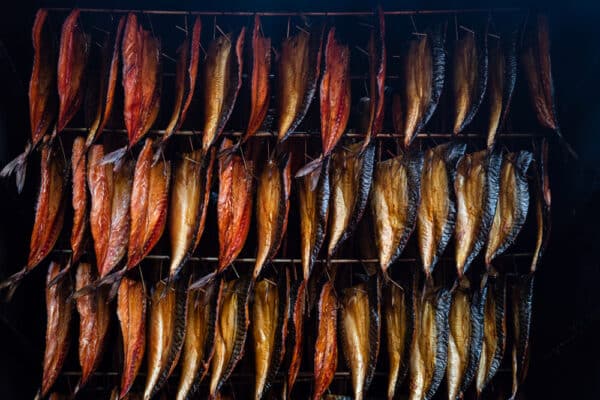
Unconventional Meats to Smoke
Over the years, I’ve loved venturing beyond the traditional boundaries of smoking, experimenting with some unconventional meats. While they may not be the first choice for most, these meats can be a delightful surprise when given the low and slow treatment in the smoker.
Here are a few of my favorite unconventional meats to smoke for those brave enough to try:
-
Goat: This might seem like a surprising choice, but goat meat is lean, flavorful, and well-suited to slow cooking in a smoker. The low fat content means it requires careful monitoring to prevent drying out, but the effort is rewarded with a wonderfully flavorful, unique taste.
-
Alligator: Now, this is certainly not your everyday choice, but don’t dismiss it without giving it a try! Alligator meat, particularly the tail, can be a real treat when smoked. It absorbs the smoky flavor wonderfully, and the end result is a tender, slightly sweet meat with a unique texture.
-
Rabbit: Lean and subtly flavored, rabbit can be a wonderful option for smoking. Wrapping it in bacon or prosciutto can add some much-needed fat and flavor during the smoking process. The resulting dish is tender, smoky, and just a little bit different!
-
Buffalo: Leaner than beef but just as flavorful, buffalo can be a fantastic alternative to traditional beef cuts. I especially enjoy buffalo brisket, which when smoked slowly, can yield an incredibly tender and flavorful dish.
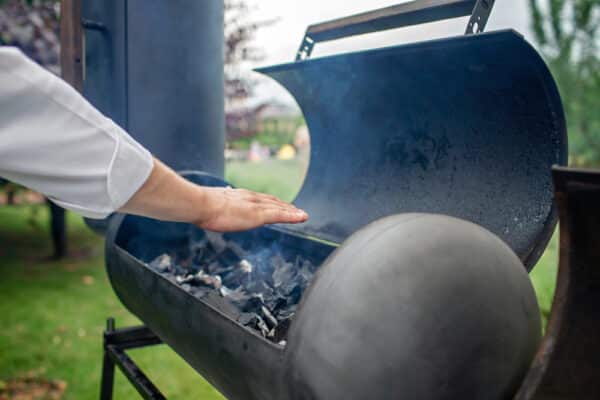
Essential Tips for Smoking Meat Successfully
After all these discussions about various types of meats and how to smoke them, I want to share some general tips and tricks that I’ve learned over the years. These pointers will help you in your journey of mastering the art of smoking, irrespective of the type of meat you’re using.
-
Understand your equipment: Every smoker is unique, with different heat distribution patterns and quirks. Spend some time understanding your smoker, how it maintains temperature, how to adjust the airflow, and how it reacts to different weather conditions.
-
Patience is key: Smoking is a ‘low and slow’ process. Rushing will only lead to subpar results. Take your time and allow the meat to absorb the smoke and break down slowly over time.
-
Temperature control: Use a good quality thermometer to monitor both the temperature of your smoker and the internal temperature of your meat. This is especially important with leaner cuts of meat that can dry out if overcooked.
-
Choice of wood: Different types of wood impart different flavors. Woods like hickory and mesquite provide a strong, robust smoke, while fruitwoods like apple or cherry give a lighter, sweeter smoke. Choose your wood to complement the flavor of the meat you’re smoking.
-
Don’t peek: It’s tempting to keep checking your meat, but every time you open the smoker, you lose heat and smoke. Try to resist the urge to peek and trust your smoker and thermometer.
-
Rest your meat: After the smoking process, let your meat rest before cutting into it. This allows the juices to redistribute throughout the meat, resulting in a moist and flavorful final product.
-
Clean your smoker: After each smoke, clean your smoker thoroughly. Built-up grease and soot can impact the flavor of your smoke and create a fire hazard.
-
Experiment: Don’t be afraid to try new things. Part of the joy of smoking is the ability to experiment with different meats, different woods, and different seasonings.
Learn More About Grilling
If you want to learn more about grilling, check out these other helpful resources!

Kevin Turner
Hi there, I'm Kevin Turner, Founder and CEO of thegrillingmaster.com. I started this website to share my passion and knowledge with you. You can leverage my years of experience as a pit master and professional to grill great food!
About The Grilling Master
Hi there, I'm Kevin Turner, Founder and CEO of thegrillingmaster.com.
My passion has always been grilling, smoking and BBQ delicious meats that satisfy my inner carnivore!
I started this website to share my passion and knowledge with you, the hungry reader who wants to prepare the perfect meal.
You can leverage my years of experience as a pit master and professional.
Send me a message and let's connect on Twitter here.


